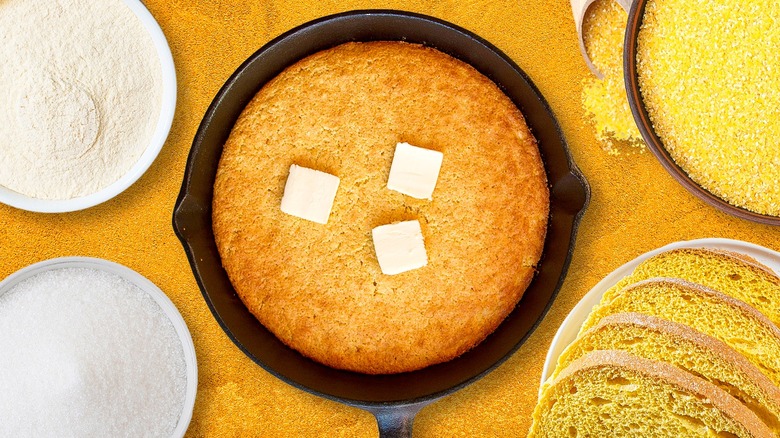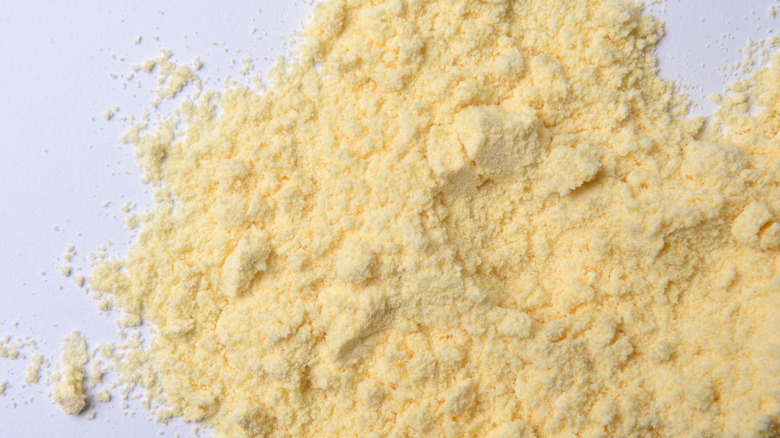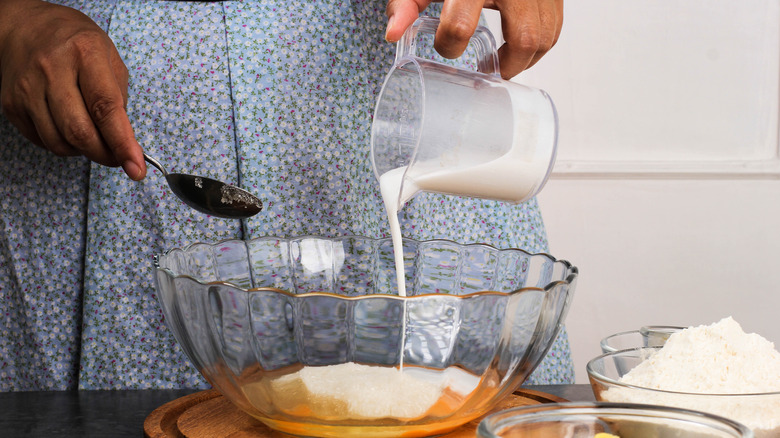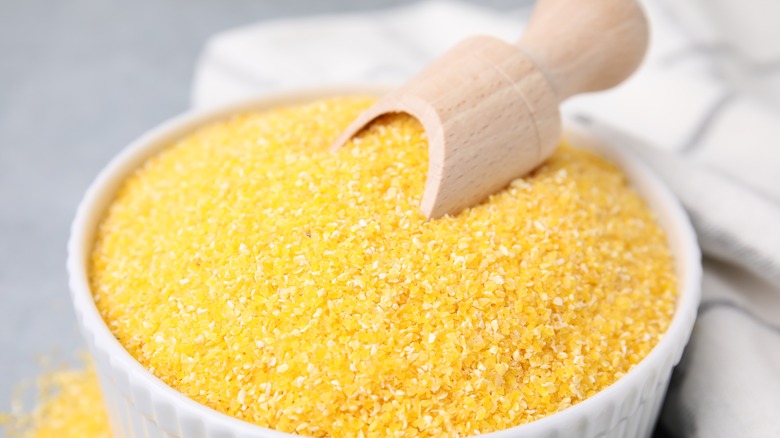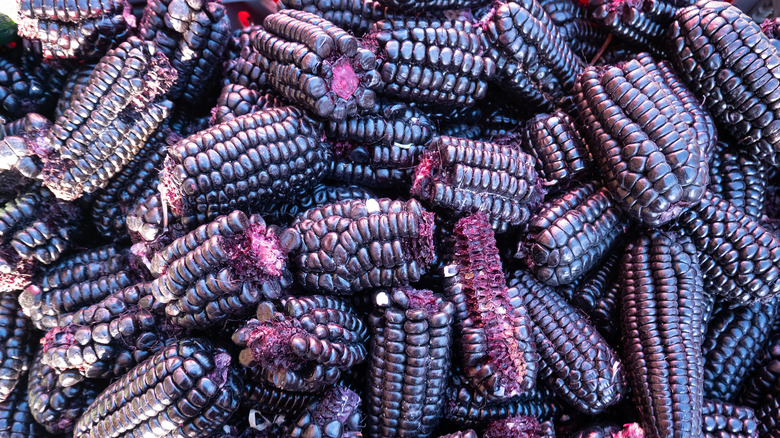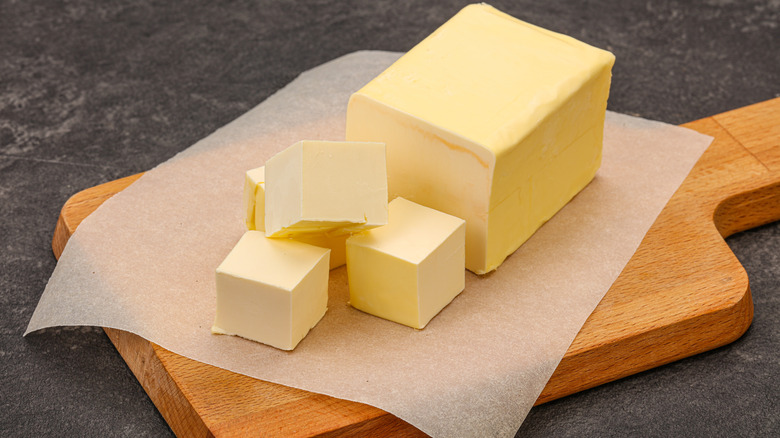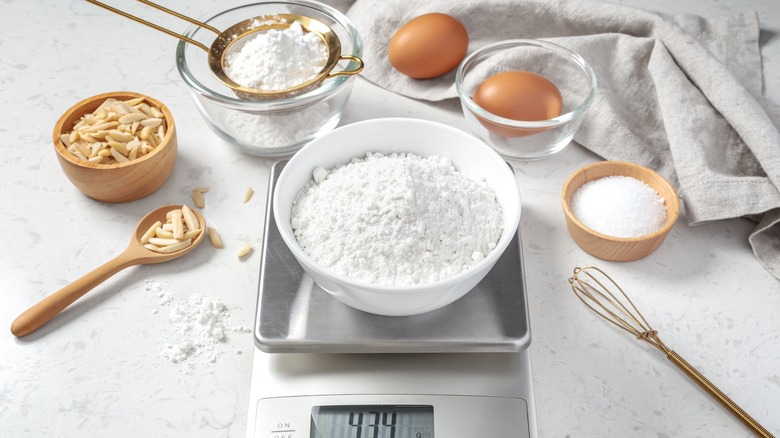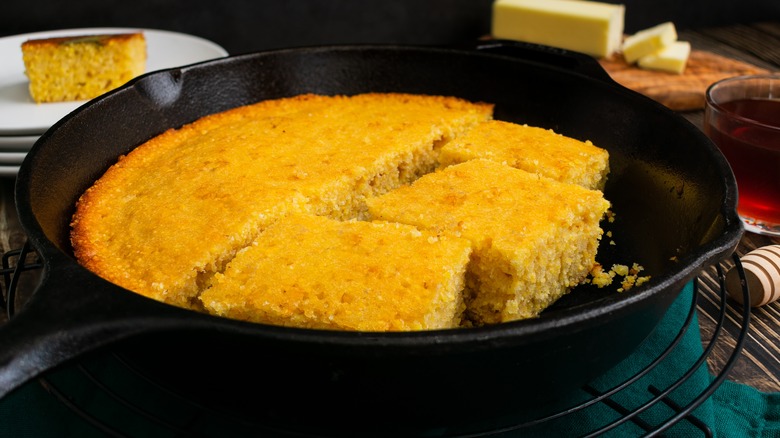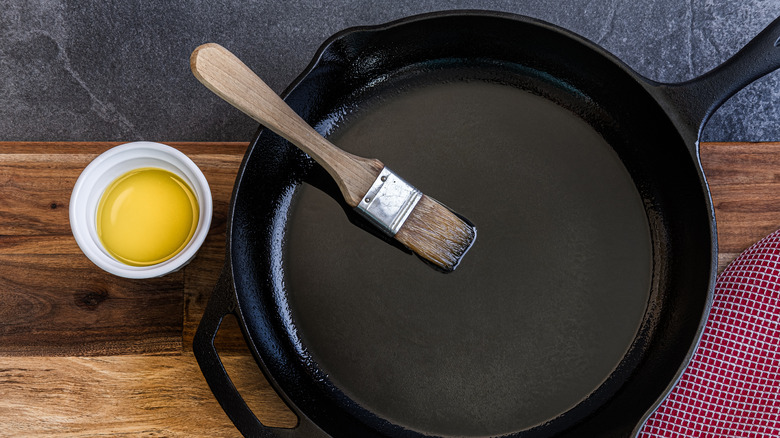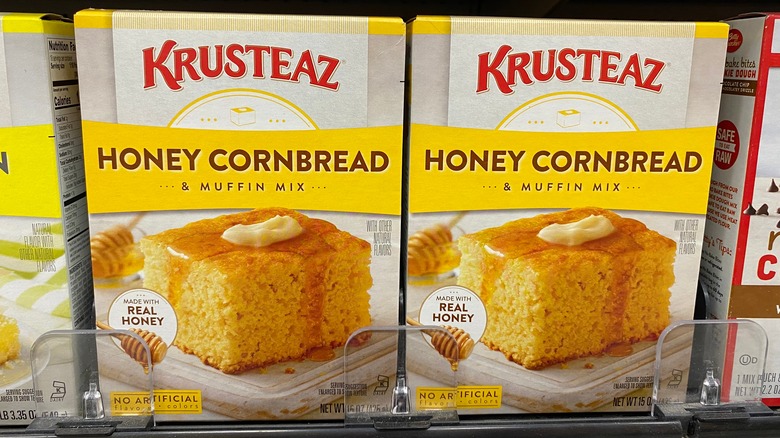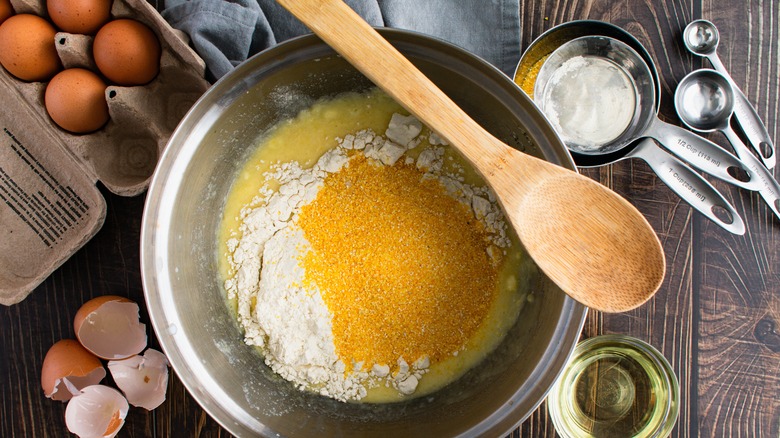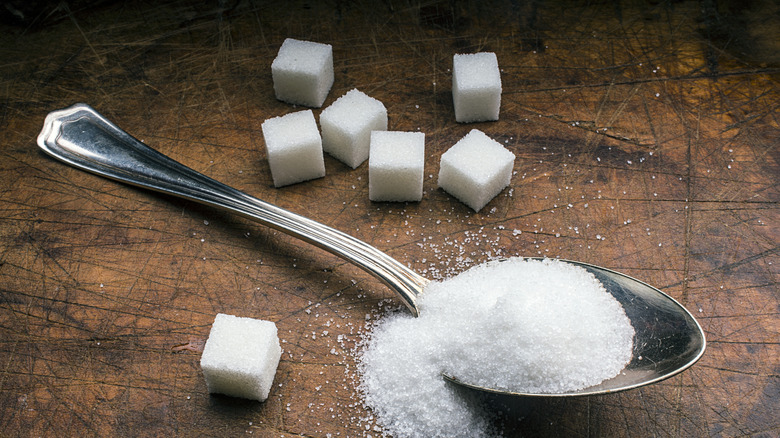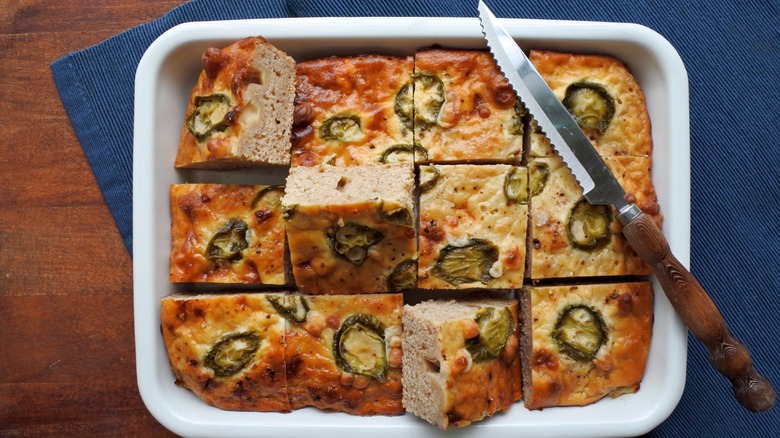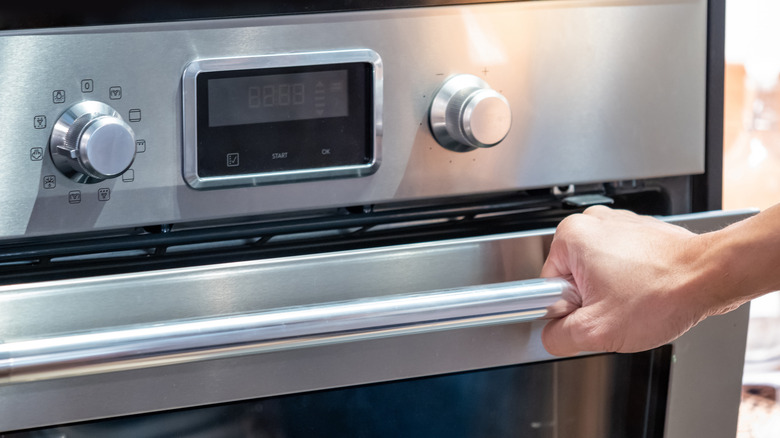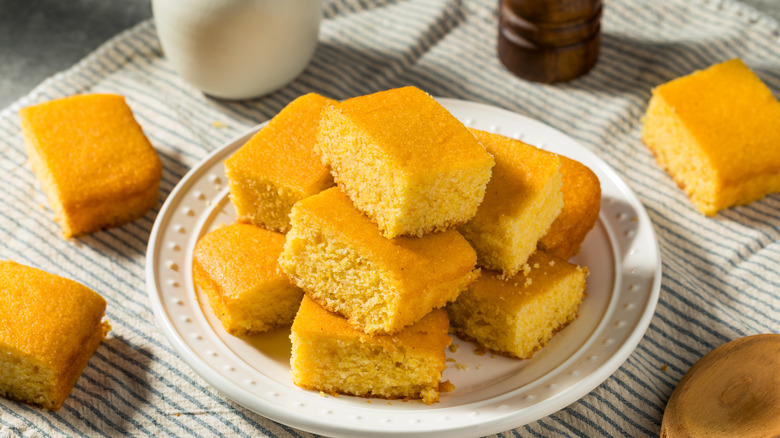14 Mistakes To Avoid When Baking Cornbread
The hall of fame of Southern sides is seemingly endless. You have your collard greens, your mac and cheese, and of course, your cornbread. If anything, cornbread is the side dish that reigns supreme for special occasions like Thanksgiving, as well as simple weeknight dinners — especially when it's served alongside a steaming bowl of chili.
Realistically, cornbread isn't that difficult to make at home — so long as you have some guidance through the process. And if you don't have a grandma looking over your shoulder or a recipe that's been passed down from generation to generation, you do have the next best thing: me. As a prolific home baker, I've tested and played with many different cornbread recipes over the years. Through this process, I've learned — often as a trial by fire — what mistakes are far too easy to make when it comes to cornbread, as well as how to fix them. These tips, along with a range of quality ingredients, will put you on a path to cornbread success, no matter how you plan to use this wonderful side dish.
1. Using the wrong size of cornmeal
Size matters when it comes to a lot of things, including your cornbread recipe. To ensure your cornbread comes out moist, you'll want to stick to a finer-ground cornmeal rather than one that is more coarsely ground. The reason for this is simple. Smaller cornmeal has a greater surface area, which means that it can absorb more liquid than your other cornmeal. Luckily, you won't have to squint to look at the cornmeal and make an arbitrary judgement about its size; most cornmeal brands will have their size written smack-dab in the middle of the packaging.
However, if you're craving cornbread with a little bit more of a nutty flavor and that unmistakable, tooth-grinding texture, you'll want to select a stone-ground cornmeal. As the name suggests, this type of cornmeal isn't ground like other conventional varieties. The processing method keeps more of the hull and the germ of the corn kernel intact, which in turn amplifies its, for lack of a better word, corny flavor. To ensure you get the best of both worlds, I would recommend adding both stone-ground and finely ground cornmeal to your recipe — but try leaning more heavily on the finely ground cornmeal to get the perfect texture and moistness.
2. Improperly measuring your cornbread ingredients
One of the biggest mistakes you're making with baking, regardless of if it's a five-layer cake or a simple, homestyle batch of cornbread, is improperly measuring your ingredients. Recipes are built on the premise that adding a certain amount of one ingredient and a certain amount of another will give you an exact result. When you're 10, 20, or more grams off, the results can snowball and mess up your recipe entirely.
Dry measurements should really be measured with a scale, rather than a measuring cup (or even worse, eyeballing). Moreover, always select a recipe that is listed in grams, rather than only in cups and spoons. They tend to be far more accurate and well-researched. Wet ingredients can be measured in a glass measuring cup, but you'll want to practice proper technique here, too — including checking the amount at eye level before you add it into your recipe.
3. Skipping the soaking step
Cornbread requires one extra step that you may not have to complete with other cornmeal-based recipes: soaking it before mixing it with the rest of your ingredients. While you might wonder how big of a difference this makes, considering how all of the ingredients get combined together anyway, I can assure you that this is one small step that will make a big difference in your recipe. The reasoning is similar to why you should always soak old-fashioned oats for a chewier oatmeal cookie; the soak will allow your cornmeal to absorb the liquid beforehand, rather than suck up all the liquid as it bakes. This ensures a cornbread that won't crumble or break apart as easily.
One option is to make a hot water cornbread recipe and combine the cornmeal, sugar, and salt with boiling hot water. My preferred method, though, is leaving the cornmeal in buttermilk overnight. The acid will tenderize the cornmeal and give it a great flavor.
4. Thinking you just have to use yellow cornmeal for a recipe
While your local grocery store may have a few options when it comes to cornmeal, if you take a peruse online, you'll find a wider array of different cornmeal colors and types that you can try for your next batch. The three primary colors include yellow cornmeal (which will leave your cornbread tasting like, you guessed it, corn) and white cornmeal, which has a less corn-forward flavor and some subtle sweet notes. Meanwhile, blue cornmeal has an absolutely beautiful hue and sweet flavor, but it's admittedly more difficult to find than other varieties.
Regardless of the variety you select, the same rules will apply. Stick with something finely ground so that the texture of your cornbread comes out moist and flavorful. A little medium-ground cornmeal could be valuable if you're craving a mealier cornbread, but the finely ground stuff is where it's at.
5. Skimping on the fat in your cornbread recipe
I understand why someone would want to cut back on the fat in a recipe. Surely, it makes the baked good a little bit lighter and cuts back the calories, but it doesn't necessarily make it tastier. The fat is an important element in the cornbread because it both binds the ingredients together and coats the flour so that the gluten doesn't develop too much. The result is a spongy cake that's brimming with flavor and has an exceptional shine.
The best fat to add to cornbread will really depend on the recipe you're going after. You can bake your cornbread with oil instead of butter if you want a tender batch with a less butter-forward flavor. Oil produces a denser bread than butter because it contains 100% fat; butter, on the other hand, is mostly fat, but it contains some water. You can also introduce extra ingredients to add moisture to your cornbread, including sour cream. The fat will lubricate the flour and also impart a subtle tang to your quick bread.
6. Forgetting the wheat flour
The name "cornbread" implies that the bread is made of corn — right? Well, sorta. In addition to the cornmeal, which gives this bread its iconic grittiness and subtle sweetness, most recipes will also call for a little bit of wheat flour. This ingredient is both literally and figuratively the glue that holds your cornbread together. Wheat flour has gluten in it, which gives the bread its structure. You can't forget it when you're making your cornbread, because it would otherwise come out like mush.
Granted, there is some room to experiment with gluten-free cornbread to get a similar texture and flavor as the regular variety. I would highly suggest working with a gluten-free measure-for-measure flour here because it has that similar strength and texture to it — all without gluten involved. If you used a gluten-free flour replacement willy nilly, like almond flour or coconut flour, your recipe might come out grittier and less structurally sound than you anticipated.
7. Cooking cornbread in anything but a cast iron skillet
There is a reason why cast iron and cornbread are often associated with one another. You need to make cornbread in your cast iron skillet because it has unparalleled heat retention. That means that it will hold the heat from the oven in and perfectly brown the underside of your cornbread. But this suggestion really only proves efficacious when you pre-heat the pan in the oven ahead of time. You can pop it in the oven as you're preparing the rest of the ingredients. Then, when you're ready to cook, grease the pan again, toss in the batter, and place it in the oven.
One of the worst kinds of pans to bake cornbread in is a glass Pyrex dish. Glass doesn't conduct heat as well as cast iron, which means you won't get nearly the same color on the bottom. It's also not really made to withstand high temperatures or pre-heating, so you won't get the same crispy edges on the outside of your cornbread as you would if you used a cast iron skillet instead.
8. Not adequately greasing or lining your pan
Greasing your pan is a critical step in the baking process, regardless of what you're making. And does anyone ever want to sit and chisel pieces of burnt-on food off a pan before washing it? To prevent cornbread from sticking to a cast iron skillet, you'll want to be sure to both pre-heat and season your skillet ahead of time. The seasoning process will cause the oil or fat to stick to the surface of the cast iron and fill in any gaps on its jagged surface. Constantly layering on that oil will help keep your cast iron non-stick. This process will also stave off any rust. Just be sure to season your cast iron pan in between uses to keep it perfectly non-stick and ensure your cornbread comes out of it rather than staying stuck inside.
If you aren't using a cast iron pan, you'll still need to line and grease your vessel of choice so that the cornbread doesn't stick to it. Parchment paper will be your best friend and will help ensure that you can easily pick your cornbread up and out of your pan. If you're lucky enough to not spill anything on your pan, you may even be able to skip a trip to the dishwasher.
9. Not trying a store-bought mix
Luckily, there are some professionals out there who have figured out the science of how to make a good industrially packaged cornbread mix. This means you can conveniently pick up a box from the store and be well on your way to a delicious batch of cornbread to accompany your chili, brisket, and more. When I personally tasted an array of store-bought cornbread mixes, I found that Bob's Red Mill made, by far, the best cornbread. When I baked cornbread muffins in a tin, I found that the color of this cornbread was impressive, as was the slight dome that graced the top of each one. It's the brand that I would unequivocally recommend for making a delicious batch of cornbread.
And where there is good cornbread, there is also bad cornbread. The store-bought cornbread mix that needs to stay out of your shopping cart, based on this same test, was Martha White's yellow cornbread and muffin mix. This mix came out far too dry and also had a chemical leavening flavor. The bottom line is that, while there are reputable store-bought brands out there, do your research before you add one to your cart.
10. Overmixing your cornbread batter
Are you noticing that your cornbread is coming out of the oven exceptionally dry? It might not be because your recipe lacks fatty ingredients or because you baked it too hot. Rather, it might be because you were a little too aggressive when it came to mixing up your batter. Since cornbread is a quick bread (made with chemical leaveners like baking soda and baking powder), it needs a gentle mix. Aggravating the batter too much will cause the gluten to stodge up, in turn creating a bite that's tough and hard rather than soft and crumbly.
To avoid overmixing, I only stir my ingredients enough so that everything is perfectly distributed and there are no dry pockets left. I'll also opt for mixing it by hand, rather than using an electric beater or a stand mixer, because I find these appliances tend to overmix the batter to the point of no return. Another way to prevent your batter from coming out too dense is mixing your dry ingredients ahead of time before adding them to the batter. If you add the leavener too early, you may beat out too much of the carbon dioxide bubbles and not get nearly as drastic of a puff.
11. Forgetting the sugar
I might be opening up the gates to hate mail on this one. Granted, sugar is the ingredient that traditional cornbread never uses, but that doesn't mean you can't add your own sweet spin to this timeless recipe that's well-suited to your palate.
I typically add just a little sugar to my cornbread. I don't like things that taste like they are straight out of Willy Wonka's candy forest, but I do think that the little bit of sugar has the potential to mellow out the mix and complement the other ingredients rather well. Moreover, sugar isn't the only ingredient you can use to sweeten up your recipe. You can add a splash of maple syrup to your batter in its place; the oaky flavors from the condiment will mesh well with savory food pairings, like chili, and add more complexity than sugar alone. Alternatively, you can also hold off and serve the cornbread with sweet toppings, like a Texas Roadhouse-copycat spiced honey butter — or just a bottle of honey for drizzling.
12. Not adding your own creative spin on the recipe
The best part about cornbread is that you can tweak the recipe with mix-ins to elevate its flavor. For example, if you like all things hot and smoky, adding jalapeños, chili powder, and cayenne pepper can help turn up the heat a notch. Or, if you're looking for something that leans more toward the savory end of things, consider adding some chopped garlic to the bowl before you pop the batter into the oven. As far as sweet things go, cinnamon and fresh fruit (like blueberries) can elevate a cornbread to new heights and transform it into a dessert, rather than just a side.
There are also ingredients you can add to your cornbread that would work well with both savory and sweet additions, including my personal favorite: brown butter. This quick, easy upgrade has all of the toasty and brown sugar flavors that your cornbread is craving. To make it at home, just cook down butter until brown specks start to appear and you start to smell a nutty aroma. You can use it to replace some of the oil or melted butter in your cornbread recipe — it's that easy!
13. Overbaking your cornbread
After you've worked so hard to build a soft, decadent loaf of cornbread, the last thing you want to do is dry it out too much in the oven. Be sure to accurately pre-heat your oven to ensure that your cornbread is ready to bake, then set your timer. As with all recipes, you'll want to avoid opening and closing the oven too much, as this may cause your bread to deflate or not cook properly.
The best way to tell that your cornbread is done baking is to take its internal temperature. It should be read between 195 F and 200 F. You can also give it the toothpick test, but I find that internal temperature readings tend to be a little more accurate. After all, how many times have you stuck something with a toothpick only to say, "Well, I think that's a couple of crumbs?"
14. Not letting cornbread cool before you slice into it
After you've worked so hard on your cornbread, you may just want to rip it right out of the oven, cut into a slice, and enjoy it. But not so fast. Your cornbread needs some time to adequately cool before you can take a slice out of it. While cornbread is undeniably best warm, you'll want to give your batch enough time for the inside to cool and solidify before you slice into it. Otherwise, it may come out more crumbly than you'd like. A mere five minutes is all you need; then you can circle around the pan with a butter knife to pop it out — or serve it straight from the skillet.
If there's any cornbread left over, you can easily place it into foil or plastic wrap, and then a larger plastic bag, to keep it fresh. Just be sure that your cornbread is completely cooled (as condensation can cause it to go bad quicker) and push all of the air out of the bag. Your cornbread should stay fresh for about three days on your counter, or you can place it in your fridge to get a few more days out of it.
